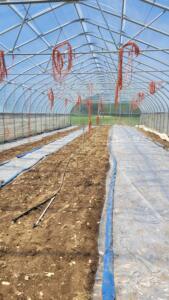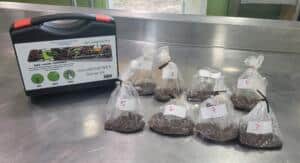Written by Mary Hathaway, OFRF’s Research & Education Program Manager

Maggie Dungan, farmer at Salad Days Farm
Salad Days farm is a diverse vegetable operation situated on 30 acres in Versailles, Kentucky. Certified organic since 2015, farmer Maggie Dungan’s interest in growing food started with an education in nutrition and the long dream for her family to be self-sustaining. The farm grows year-round in the field and in hoop houses to supply their on-farm store, restaurants, schools, and four weekly farmers’ markets.
Maggie works hard to keep mechanization on her farm minimal, focusing on cover cropping, minimal tillage, and other soil health conservation practices. She keeps only 2-4 acres of the farm in production, allowing her to focus on the quality of her systems to grow high-value and sustainable food for her community.
Impact of Solarization on Soil Microbiology

Solarization plots in the high tunnel.
Maggie was first exposed to the practice of solarization using clear plastic in 2022 when the farm participated in a research project with the University of Kentucky. The project studied the effect of solarization in high tunnels on root-knot nematode populations. She was impressed by the results of the trial and saw first-hand how this technique impacted a persistent soil pathogen.
Organic farmers like Maggie, who focus on minimizing tillage, must still manage pathogens, weeds, and other common challenges, and solarization offers potential benefits. However, Maggie was concerned about the impact of the treatment on her soil health, and had some questions – if solarization kills pathogens, won’t it kill the good microbiology, too? How does heat smothering with a plastic tarp impact soil microbial activity? What is the impact on fungal-to-bacterial ratios?
Before beginning to incorporate soil solarization into her field plans, Maggie wanted some answers, and applied for OFRF’s Farmer-Led Trial program to help her build out a solid research plan and find reliable results that would have a positive impact on her operation.
Farm Trial Plan
With technical support from OFRF, the Salad Days trial on soil solarization took shape. By refining her research question to: “What is the temporal and population effect of solarization on the beneficial microbes in the high tunnel?” the research team was able to build an approachable and testable project on the farm.
Maggie and OFRF built out a block design with two treatments: No soil solarization in the hoop house, used as her control, or regular practice compared to soil solarization in the hoop house. Using her 30’x100’ hoop house as the location for the trial and mapping areas for the treatments, Maggie used a microbiometer to take three different soil samples: first a baseline reading, then one 2 weeks and 4 weeks, respectively, after the tarp had been removed from the treatment plots.
What is solarization?
Solarization is the process of placing a clear plastic tarp over a field or garden bed to heat up the soil underneath. The intention of solarization is to kill weeds or grass, but is also known to reduce pathogen populations in the soil.
On-Farm Trial Updates
Maggie took her final soil reading in early August, four weeks after she removed the tarps from their beds. While she originally hypothesized that the soil microbes would bounce back, she guessed that their populations would need some time to recover after the tarp treatment.

Soil testing for the on-farm trial.
The OFRF team has begun to work with the data collected to get an understanding of any significant differences. In Maggie’s experiment, we see that microbial biomass over time differed depending on whether or not the area had been tarped. Under solarization, microbial biomass increased over time, while biomass decreased over time in areas that had not been tarped. Also, the fungal-to-bacterial ratio was higher under solarization than in bare soil. The ratio was not affected by time after tarp removal.
The data is compelling, and OFRF will be looking into similar research to better understand the why of these results and give Maggie the assurance she is looking for to deploy a practice that continues to foster the health of her soil and improve her farming system.
“Being able to tailor a research project specific to my farm but useful to all growers has been a great opportunity and having the technical assistance from OFRF has been integral.”
– Maggie Dungan, Salad Days Farm

Research Results
Maggie Dungan’s farmer-led trial examined the impact of soil solarization on microbial communities in high tunnels. Using a MicroBIOMETER, she measured soil microbial biomass and fungal-to-bacterial ratios before and after solarization to assess how the treatment affected soil life.
Key Findings:
- Microbial Biomass Increased Over Time: Contrary to expectations, soil microbial biomass was higher in solarized plots compared to non-solarized plots, suggesting that the practice does not harm beneficial microbes.
- Fungal-to-Bacterial Ratio Shifted: Solarized plots had a higher fungal-to-bacterial ratio, indicating a potential shift in soil microbiology post-treatment.
- Potential for Weed & Pathogen Management: While originally concerned about negative effects, Maggie’s findings suggest that soil solarization can be an effective weed and pathogen control method without long-term damage to soil biology.
Encouraged by these results, Maggie plans to continue using soil solarization as part of her organic weed and pathogen management strategy. Future research could explore how different durations of solarization impact microbial communities and soil health over multiple growing seasons.
For full details on the study’s methodology and results, read the final report.
This story is part of a series profiling farmers who are taking part in OFRF’s Farmer-Led Trials (FLT) program. Farmers receive technical support from OFRF to address their challenges through structured on-farm trials. To learn more about OFRF’s Farmer-Led Trials Program, visit our website page at https://ofrf.org/research/farmer-led-research-trials/
To learn more about soil solarization, check out these helpful resources on the web: https://extension.umn.edu/planting-and-growing-guides/solarization-occultation
To learn more about Salad Days Farm, visit https://www.saladdaysfarm.com



